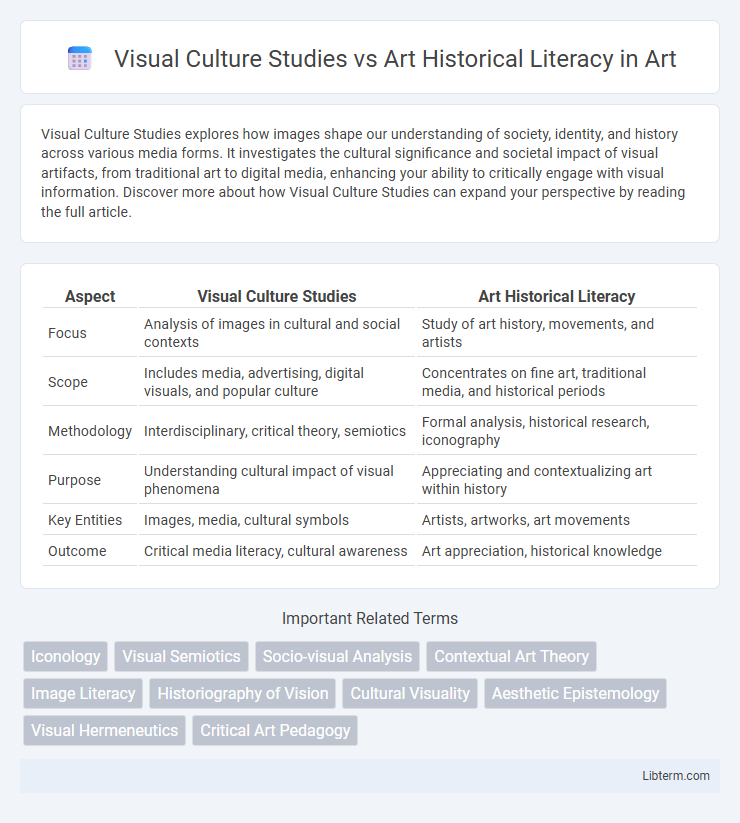Visual Culture Studies explores how images shape our understanding of society, identity, and history across various media forms. It investigates the cultural significance and societal impact of visual artifacts, from traditional art to digital media, enhancing your ability to critically engage with visual information. Discover more about how Visual Culture Studies can expand your perspective by reading the full article.
Table of Comparison
| Aspect | Visual Culture Studies | Art Historical Literacy |
|---|---|---|
| Focus | Analysis of images in cultural and social contexts | Study of art history, movements, and artists |
| Scope | Includes media, advertising, digital visuals, and popular culture | Concentrates on fine art, traditional media, and historical periods |
| Methodology | Interdisciplinary, critical theory, semiotics | Formal analysis, historical research, iconography |
| Purpose | Understanding cultural impact of visual phenomena | Appreciating and contextualizing art within history |
| Key Entities | Images, media, cultural symbols | Artists, artworks, art movements |
| Outcome | Critical media literacy, cultural awareness | Art appreciation, historical knowledge |
Defining Visual Culture Studies
Visual Culture Studies examines the broad spectrum of visual phenomena, including media, popular culture, and everyday imagery, expanding beyond traditional art historical boundaries. This interdisciplinary field emphasizes the social, political, and cultural contexts that shape visual meanings, integrating perspectives from sociology, anthropology, and media studies. Defining Visual Culture Studies involves recognizing its focus on diverse visual forms and their impact on identity, power structures, and public discourse.
Understanding Art Historical Literacy
Understanding Art Historical Literacy involves analyzing the formal elements, context, and meaning of artworks within historical periods and movements to grasp their cultural significance and evolution. This literacy emphasizes critical skills in interpreting artistic techniques, iconography, and symbolism, enabling a deeper appreciation of art's role in society throughout history. Unlike Visual Culture Studies, which broadly examines images and media in contemporary contexts, Art Historical Literacy remains rooted in traditional art historical methodologies and chronologies.
Key Theoretical Foundations
Visual Culture Studies draws from semiotics, cultural theory, and media studies to analyze the social and political contexts of images, emphasizing power structures and audience interpretation. Art Historical Literacy centers on formal analysis, iconography, and historical context, focusing on the development, style, and meaning of artworks within specific art periods. Both fields incorporate interdisciplinary methods but differ in their emphasis on interpretive frameworks versus historical lineage and aesthetic evaluation.
Methodological Differences
Visual Culture Studies emphasizes interdisciplinary methods integrating media theory, cultural studies, and critical theory to analyze contemporary visual phenomena beyond traditional art objects. Art Historical Literacy focuses on formal analysis, iconography, and contextualizing artworks within historical periods, emphasizing chronology and connoisseurship. The methodological divergence lies in Visual Culture's broader cultural and social scope compared to Art History's concentrated study of canonical art and artists.
Approaches to Visual Analysis
Visual Culture Studies broadens the scope of visual analysis by including everyday images, media, and cultural artifacts, emphasizing context, power relations, and audience interpretations. Art Historical Literacy centers on analyzing traditional fine art using formal elements, stylistic periods, and artist intent, grounded in historical and aesthetic knowledge. Approaches in Visual Culture Studies are interdisciplinary and critical, while Art Historical Literacy relies on established art historical methodologies and visual formalism.
Role of Context in Interpretation
Visual Culture Studies emphasizes the role of socio-political and cultural contexts in shaping the meaning and reception of visual artifacts, broadening interpretation beyond formal aesthetic analysis. Art Historical Literacy focuses on historical context, provenance, and stylistic development to understand artworks within established chronological and cultural frameworks. Both approaches recognize context as essential, but Visual Culture Studies prioritizes contemporary societal influences while Art History underscores the artwork's placement within a historical continuum.
Cultural Significance and Reception
Visual Culture Studies emphasizes the analysis of cultural artifacts within their societal contexts, exploring how images shape and reflect collective identity, ideology, and power dynamics. Art Historical Literacy focuses on the formal elements and historical development of artworks, tracing stylistic evolution and artistic intentions across periods. The reception in Visual Culture Studies prioritizes audience interpretation and media influence, whereas Art Historical Literacy centers on expert critique and canonical valuation.
Expanding the Canon: What Is Studied?
Visual Culture Studies broadens the scope of academic inquiry by including diverse forms of visual media such as film, advertising, digital imagery, and popular culture, challenging traditional boundaries of the art historical canon. Art Historical Literacy focuses primarily on classical artworks and established masterpieces, emphasizing formal analysis and historical context within recognized art movements. Expanding the canon in Visual Culture Studies encourages the inclusion of marginalized voices and contemporary visual practices, fostering a more inclusive and interdisciplinary understanding of visual phenomena.
Interdisciplinary Applications
Visual Culture Studies integrates diverse fields such as sociology, anthropology, and media studies to analyze imagery's role in shaping societal values and identities. Art Historical Literacy emphasizes contextual understanding of artistic movements, materials, and historical narratives, enriching critical analysis within traditional art disciplines. Interdisciplinary applications harness Visual Culture Studies for examining contemporary media and popular culture while employing Art Historical Literacy to deepen interpretation of historical aesthetics and cultural heritage.
Implications for Contemporary Visual Education
Visual Culture Studies expands beyond traditional Art Historical Literacy by incorporating diverse media, popular culture, and digital technologies, enriching the scope of contemporary visual education. This interdisciplinary approach encourages critical thinking about visuality's social, political, and cultural contexts, fostering media literacy essential for navigating today's visual landscape. Integrating Visual Culture Studies into curricula promotes inclusivity and relevance, equipping learners with analytical skills for both historical art interpretation and contemporary visual communication.
Visual Culture Studies Infographic

 libterm.com
libterm.com